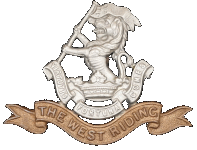
Ashtead War
Memorials - WWI - Sgt Fred Corbett
2nd Bn, Duke of Wellington's (W Riding Regt)

Registered at Epsom for September Quarter 1872 may be found the marriage of Henry Corbett [born. ca 1850 at Ashtead], General Labourer, to Judith Eliza Roffey [born Epsom, registered 12/1852 as Eliza Judith]. They set up home in Ashtead and three children followed by 1881. The birth of a further son, Frederick, was registered at Epsom, 12/1883.
Fred was employmed as a Stable Groom but, on 29 April 1901 aged 18 years 7 months, he enlisted in London for Short Service (basically 7 years with the Colours followed by 5 years in the Reserve) in the West Riding Regiment. The Anglo-Boer War was in progress but he did not receive a posting to South Africa until 2 June 1902, after hostilities had been brought to a close. On 8 September 1902 he was re-deployed with 2nd Battalion to the West Indies. Having been permitted, during 1904, to extend his service with the Colours to 8 years he moved to 1st Bn. on 4 November 1905. After returning to the UK, probably Aldershot, 9 January 1909, he was transferred to the Reserve, with his own consent, before expiry of Army Service with effect from 7 March 1909.
As a civilian, but reservist, Frederick married Rhoda Elizabeth Cook(e) [birth registered Wimborne. Dorset 6/1886], Spinster, at St Giles’ on 6 July 1912 . They lived at 25 Grove Road, Ashtead. Their only child, Frederick Bernard, was born 4 April 1913.
Britain declared war on Germany, 4 August 1914, and Frederick had been mobilised at Halifax the following day. He arrived in France on 10 August before disembarking with his unit to form part of 12th Brigade, 4th Division. By 19 September he had been wounded in the hand.
2nd Battalion, West Riding Regiment became involved in the Battle of Le Transloy, 1-18 October 1916. On the afternoon of 12 October, the day on which Sergeant Frederick Corbett lost his life, a major assault had been launched upon Le Transloy and the Butte de Warlencourt. He died of wounds. The British attack took place along a four mile front between Eaucourt and Bapaume but overall is regarded as having been a failure.
http://www.ww1battlefields.co.uk/somme/flers.html
Since Fred’s body was not located, or remained unidentified, his name is recorded on the Thiepval Memorial. He was awarded the 1914 (“Mons”) Star, with Clasp for operations under fire before 22 November 1914, with Victory & British War Medals.
During WW1, Henry, Frederick’s father, lived in 2 The Mays, Woodfield Lane, one of a pair of cottages built by George Sayer of the Brewery Inn - by whom, it is assumed, he had been employed as a Brewer’s Cellarman.
text: Brian Bouchard: if you can add to this page please contact the editor
page added 12 Mar 2009